The construction industry is a significant contributor to global warming, accounting for about 40% of global energy and industrial-related CO2 emissions. However, energy-saving design, construction, and operations practices can curb emissions by 12.8% by 2035. As the world grapples with climate change, the industry is under pressure to adopt sustainable construction solutions.
Green building solutions have emerged as a critical component, offering benefits like reduced energy consumption and improved indoor air quality. According to a report by Maximize Market Research, the global green building solutions market is expected to grow significantly, driven by the need for eco-friendly building materials and sustainable practices.
Key Takeaways
- The construction industry is a major contributor to global CO2 emissions.
- Energy-saving practices can significantly reduce emissions by 2035.
- Sustainable construction solutions are crucial for mitigating climate change.
- The global green building solutions market is expected to grow significantly.
- Eco-friendly building materials are driving the adoption of green building solutions.
Understanding Green Building Principles
Sustainable design and construction methods are at the heart of green building principles, aiming to minimize environmental impact. Green building solutions comprise environmentally conscious practices, advanced technologies, and strategies used in the designing, construction, and manufacturing process of buildings.
Definition of Green Building
Green building refers to the practice of creating structures that are environmentally responsible, socially beneficial, and economically viable. This involves adopting a range of strategies, from energy-efficient design to the use of eco-friendly building materials. By understanding these principles, builders and architects can create structures that not only minimize environmental impact but also provide healthy, productive spaces for occupants.
Benefits of Green Building
The benefits of green building are multifaceted, including reduced energy consumption, lower operating costs, and improved occupant health. Green buildings also contribute to a more sustainable future by reducing greenhouse gas emissions and conserving natural resources. For more information on cost-effective green building solutions, you can refer to guides like cutting construction costs in Africa, which highlight the economic benefits of sustainable construction practices.
Key Components of Sustainable Design
Sustainable design is a critical component of green building, encompassing various elements such as energy-efficient systems, water conservation measures, and the use of recycled materials. The following table outlines some key components and their benefits:
| Component | Description | Benefits |
|---|---|---|
| Energy-Efficient Systems | Systems designed to reduce energy consumption | Lower energy bills, reduced carbon footprint |
| Water Conservation Measures | Systems that reduce water usage | Water savings, lower utility bills |
| Recycled Materials | Materials reused from previous constructions | Reduced waste, conservation of resources |
By incorporating these components, builders can create structures that are not only sustainable but also cost-effective in the long run. The use of green building technology is pivotal in achieving these goals, as it enables the efficient use of resources and minimizes environmental impact.
Importance of Cost-Effective Solutions
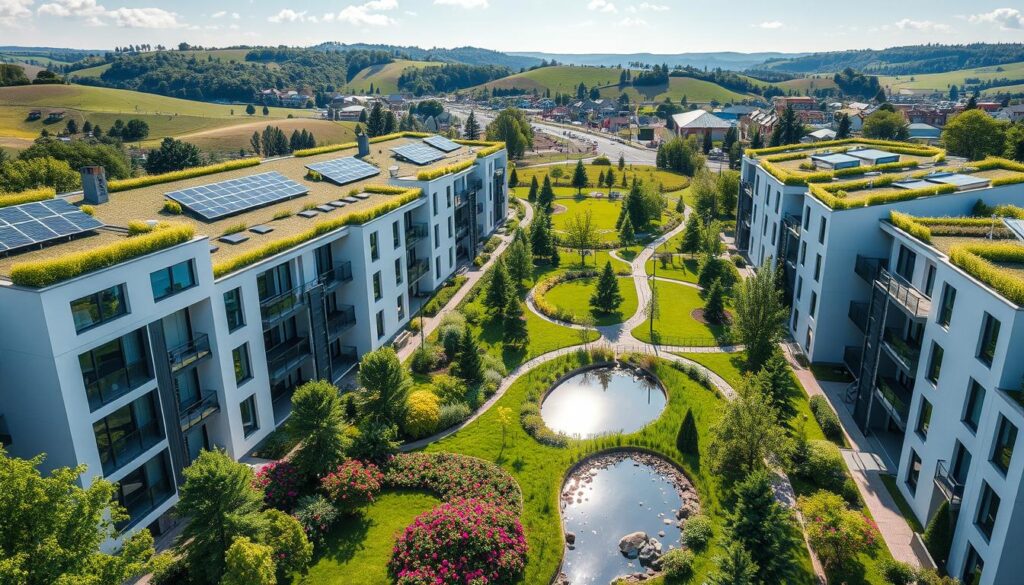
As the world shifts towards sustainable construction, the importance of cost-effective green building solutions cannot be overstated. The initial investment in green building solutions is often higher than traditional construction methods, but the long-term savings and benefits can be significant, making green buildings a cost-effective option in the long run.
One of the primary challenges facing the adoption of green building solutions is the perceived high upfront cost. However, cost-effective solutions can be achieved by balancing budget and sustainability considerations. By adopting energy-efficient design and materials, builders can reduce energy consumption and lower operating costs over the life of the building.
Balancing Budget and Sustainability
Achieving a balance between budget and sustainability is crucial for the success of green building projects. This involves careful planning and selection of materials and technologies that offer both environmental benefits and cost savings. Energy-efficient systems and sustainable materials are key components that can help reduce the overall cost of a project.
Developers can explore various strategies to balance budget and sustainability, such as:
- Conducting thorough cost-benefit analyses
- Selecting materials that are both eco-friendly and cost-effective
- Incorporating energy-efficient technologies
Economic Benefits of Green Buildings
Green buildings offer numerous economic benefits, including reduced energy costs, increased property values, and enhanced marketability. These benefits can lead to significant savings for building owners and occupants. Moreover, green buildings can contribute to a healthier and more productive environment, which can have positive impacts on occupant health and productivity.
Long-term Savings Through Efficiency
The long-term savings associated with green buildings are a major driver of their adoption. By reducing energy consumption and water usage, green buildings can significantly lower operating costs. Additionally, green buildings often require less maintenance and can have longer lifespans than traditional buildings, further contributing to their cost-effectiveness.
In conclusion, cost-effective green building solutions are essential for promoting sustainable construction practices. By balancing budget and sustainability considerations, developers can create buildings that are not only environmentally friendly but also economically viable.
Popular Green Building Materials
Green building materials play a significant role in sustainable construction, offering numerous benefits for the environment and building occupants. The choice of materials is critical in reducing the environmental impact of buildings, from the extraction and processing of raw materials to the building’s operational energy use.
The use of sustainable materials can significantly reduce waste, conserve natural resources, and improve indoor air quality. Builders and architects are increasingly turning to eco-friendly materials to meet the growing demand for green buildings.
Eco-Friendly Insulation Options
Eco-friendly insulation is a crucial component of green building, helping to reduce energy consumption and minimize environmental impact. Some popular eco-friendly insulation options include:
- Recycled denim insulation, which is made from recycled jeans and offers a high level of thermal performance.
- Fiberglass insulation made from recycled glass, which reduces waste and conserves raw materials.
- Sheep’s wool insulation, a natural, renewable resource that provides excellent thermal insulation.
Recycled and Renewable Resources
The use of recycled and renewable resources is a key aspect of sustainable building. Materials such as reclaimed wood, recycled metal, and sustainably sourced timber are in high demand. These materials not only reduce waste but also help to conserve natural resources.
| Material | Benefits | Examples |
|---|---|---|
| Reclaimed Wood | Reduces waste, unique aesthetic | Old barns, wooden structures |
| Recycled Metal | Conserves raw materials, durable | Aluminum cans, steel beams |
| Sustainably Sourced Timber | Renewable resource, carbon sequestration | FSC-certified wood products |
Low-Impact Construction Techniques
Low-impact construction techniques are essential for minimizing the environmental footprint of building projects. Techniques such as modular construction, prefabricated building components, and the use of locally sourced materials can significantly reduce waste and lower emissions.
By adopting these techniques and materials, builders can create sustainable, eco-friendly buildings that not only reduce environmental impact but also provide healthier spaces for occupants.
Innovative Technologies in Green Building
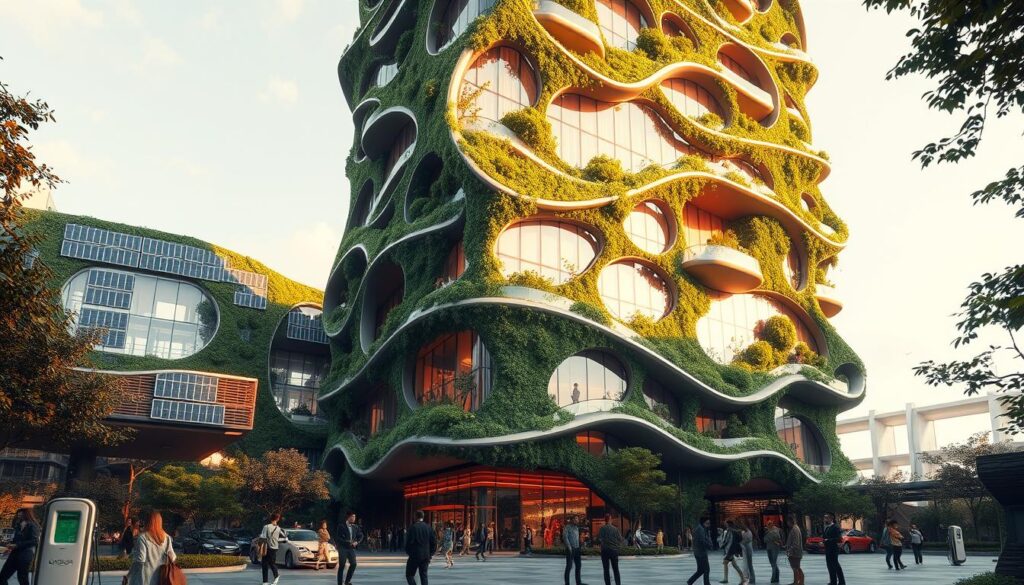
The integration of innovative technologies is revolutionizing the green building sector. By leveraging cutting-edge solutions, builders can create structures that are not only environmentally friendly but also highly efficient and cost-effective.
Smart Building Systems
Smart building technologies, such as automated lighting and temperature control systems, can significantly reduce energy consumption and improve occupant comfort. These systems use advanced sensors and data analytics to optimize building performance in real-time.
For instance, smart thermostats can learn the temperature preferences of occupants and adjust the temperature accordingly, reducing energy waste. Similarly, automated lighting systems can adjust lighting levels based on the time of day and occupancy, further reducing energy consumption.
Solar Energy Solutions
Solar energy is a key component of green building technology. By harnessing the power of the sun, buildings can reduce their reliance on fossil fuels and lower their carbon footprint. Solar panels can be integrated into building design in various ways, from rooftop installations to building-integrated photovoltaics (BIPV).
For more information on sustainable building materials, visit https://worldcivilsociety.com/sustainable-building-materials/.
Energy-Efficient Appliances
Energy-efficient appliances are another crucial aspect of green building. These appliances use advanced technologies to minimize energy consumption while maintaining performance. Examples include LED lighting, energy-efficient HVAC systems, and smart power strips.
By incorporating energy-efficient appliances into building design, builders can significantly reduce the overall energy consumption of the building, leading to cost savings and a reduced environmental impact.
International Regulations and Standards
As the world shifts towards sustainable construction, understanding international regulations and standards for green building becomes increasingly crucial.
Regulatory frameworks are being put in place globally to ensure that buildings meet certain standards for energy efficiency and environmental responsibility. Builders and architects must be aware of these regulations to ensure compliance and achieve certification.
Overview of Global Green Building Codes
Green building codes and regulations vary widely across different countries and regions. For instance, some countries have adopted specific codes like the International Energy Conservation Code (IECC), while others have their own national or regional standards.
Understanding these codes is critical for international projects. Builders can refer to resources like IFC’s insights on building green in emerging to stay informed about global green building practices.
LEED Certification and its Impact
LEED (Leadership in Energy and Environmental Design) certification is a widely recognized standard for green buildings. It provides a framework for designing, constructing, and operating buildings that are environmentally friendly and sustainable.
Achieving LEED certification can have a significant impact on a project’s success, enhancing its market value and demonstrating a commitment to environmental stewardship.
International Energy Conservation Codes
The International Energy Conservation Code (IECC) is another critical standard that sets forth energy efficiency requirements for buildings. Compliance with IECC can significantly reduce energy consumption and environmental impact.
For more information on emerging green building innovations and their compliance with international standards, visit World Civil Society’s page on emerging green building.
Case Studies of Successful Projects
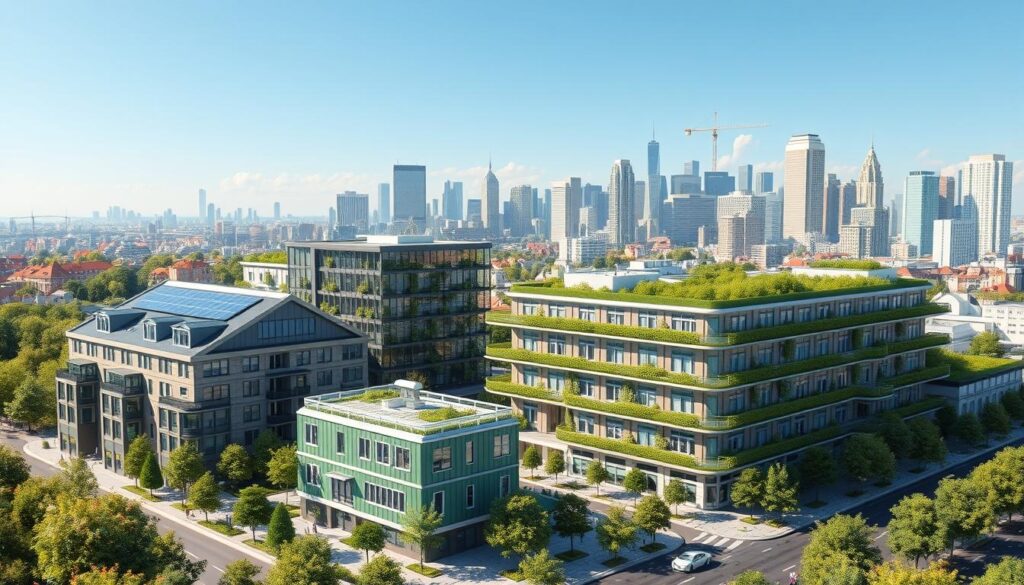
International examples of successful green buildings demonstrate the feasibility and benefits of sustainable construction. These projects not only reduce environmental impact but also offer economic advantages through energy efficiency and reduced operational costs.
Highlighting International Examples
Several notable green building projects around the world serve as exemplary models. For instance, the Greenstone Building in Yellowknife, Canada, is a prime example of sustainable design in a challenging Arctic environment. Similarly, numerous sustainable construction projects in China have showcased innovative green building techniques on a large scale.
These international examples provide valuable insights into the application of green building principles in diverse contexts. By studying these projects, architects and builders can gain a deeper understanding of how to adapt sustainable practices to different regions and climates.
Lessons Learned from Failed Projects
While many green building projects have been successful, there are also lessons to be learned from those that have faced challenges. Analyzing the reasons behind these challenges can help in developing more effective strategies for future projects. For example, some projects may have struggled with higher upfront costs or difficulties in integrating new technologies.
Understanding these challenges is crucial for improving the success rate of green building initiatives. By learning from past experiences, the industry can move towards more sustainable and resilient construction practices.
Best Practices from Successful Implementations
Successful green building projects often share certain best practices that contribute to their success. These include thorough planning, the use of locally sourced materials, and the incorporation of energy-efficient technologies. For instance, projects that have achieved LEED certification have demonstrated a commitment to sustainability through rigorous environmental design and construction standards.
| Best Practice | Description | Benefit |
|---|---|---|
| Thorough Planning | Detailed analysis of project requirements and environmental impact. | Reduced risk and improved sustainability. |
| Locally Sourced Materials | Using materials available locally to reduce transportation emissions. | Lower carbon footprint and support for local economy. |
| Energy-Efficient Technologies | Incorporating technologies that reduce energy consumption. | Lower operational costs and reduced environmental impact. |
By adopting these best practices, future green building projects can enhance their sustainability and success.
Financing Green Building Initiatives
To make green building initiatives viable, effective financing strategies are essential. Financing is a critical aspect of green building development, and by adopting the right strategies, builders and developers can overcome the financial challenges associated with sustainable construction.
Strategies for Cost Management
Effective cost management is crucial for the success of green building projects. This involves careful planning and budgeting to ensure that costs are controlled throughout the project lifecycle. Techniques such as value engineering and life-cycle costing can help in identifying cost-saving opportunities without compromising on sustainability goals.
By leveraging cost management strategies, developers can reduce the financial risks associated with green building projects. This includes negotiating with suppliers, optimizing resource allocation, and implementing efficient project management practices.
Grants and Incentives for Eco-Friendly Builds
Various governments and organizations offer grants and incentives to encourage eco-friendly construction practices. These can include tax credits, subsidies, and low-interest loans. Identifying and accessing these incentives can significantly reduce the financial burden of green building projects.
- Research and explore available grants and incentives
- Ensure compliance with the eligibility criteria
- Prepare a compelling application to secure funding
Investing in Sustainable Technologies
Investing in sustainable technologies is a key aspect of green building financing. While the initial investment in sustainable technologies can be higher, the long-term benefits include reduced energy consumption, lower operational costs, and increased property value.
Developers can explore various financing options for sustainable technologies, including energy-efficient equipment and renewable energy systems. This not only enhances the environmental performance of the building but also provides a competitive edge in the market.
Community Engagement and Green Building
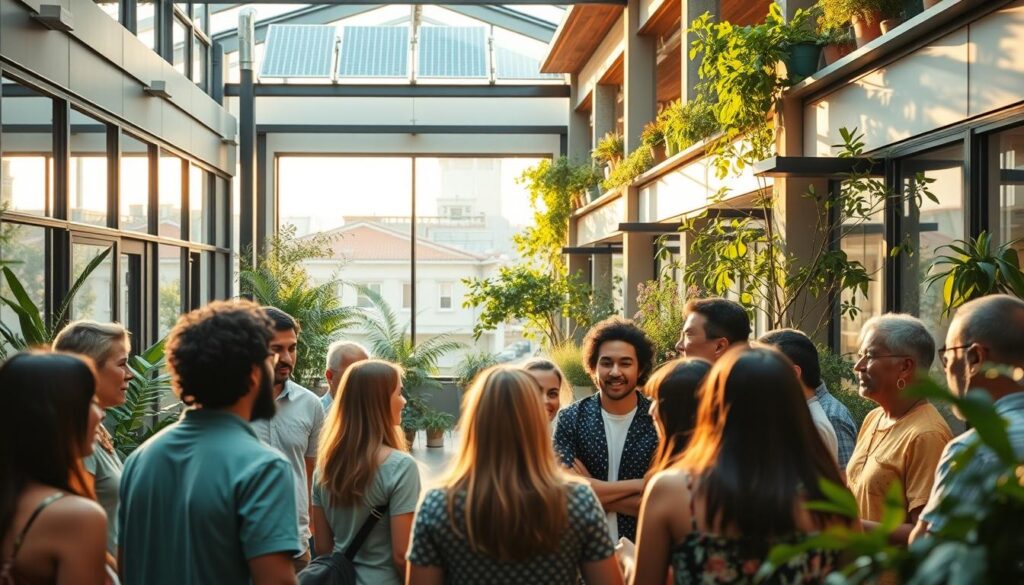
Community engagement plays a vital role in ensuring green building projects meet local needs. By involving stakeholders and local communities in the development process, builders and architects can create projects that are more responsive to local priorities.
Involving Stakeholders and Local Communities
Effective stakeholder involvement is critical for the success of green building initiatives. This involves not just informing the community about the project, but actively seeking their input and feedback. Public meetings and workshops are excellent ways to engage with the community, allowing for a two-way dialogue that can lead to better project outcomes.
For instance, a green building project in a local community might hold a series of public meetings to discuss the project’s design and features. This not only helps in gathering valuable feedback but also in building trust among the community members.
Benefits of Community-Driven Initiatives
Community-driven initiatives offer numerous benefits, including increased community support and better project outcomes. When local stakeholders are involved in the decision-making process, they are more likely to support the project, reducing the likelihood of delays or opposition.
| Benefits | Description |
|---|---|
| Increased Support | Community-driven projects often enjoy higher levels of support from local stakeholders. |
| Better Outcomes | Involving the community in decision-making leads to projects that better meet local needs. |
| Enhanced Trust | Transparency and community engagement foster trust between project developers and the community. |
Building Trust Through Transparency
Transparency is key to building trust between project developers and the community. By being open about the project’s goals, challenges, and progress, developers can foster a positive relationship with the community.
Clear communication about the project’s benefits and potential impacts helps in managing expectations and addressing concerns proactively.
By prioritizing community engagement and transparency, green building projects can not only achieve their sustainability goals but also contribute to the well-being of the local community.
Addressing Cultural Differences
In the realm of green building, cultural differences are not just a consideration, but a cornerstone of successful project delivery. As green building practices continue to evolve, it’s essential to recognize the importance of cultural differences and local building practices.
Understanding Local Building Practices
Understanding local building practices is critical for the success of green building projects in international markets. This involves not only being aware of the materials and techniques used locally but also understanding the cultural significance of certain architectural features.
For instance, in some cultures, certain building orientations or designs are believed to bring good fortune or prosperity. By incorporating these elements, builders can create structures that are not only sustainable but also culturally relevant.
Tailoring Solutions to Various Markets
Tailoring green building solutions to various international markets requires a deep understanding of local regulations, climate conditions, and cultural preferences. This might involve using locally sourced materials, adapting designs to suit local architectural styles, or incorporating traditional building techniques into modern constructions.
- Conduct thorough research on local building practices and cultural norms.
- Engage with local communities and stakeholders to understand their needs and preferences.
- Adapt green building designs and materials to suit local conditions and cultural contexts.
Respecting Cultural Heritage in Design
Respecting cultural heritage in green building design is about more than just preserving historical buildings; it’s also about incorporating elements of cultural heritage into new constructions. This can include using traditional materials, replicating historical architectural features, or designing buildings that complement their cultural and historical context.
By doing so, architects and builders can create green buildings that are not only environmentally sustainable but also culturally significant, enhancing the sense of community and identity.
Training and Certification for Professionals

As the green building industry continues to expand, the need for skilled professionals with specialized knowledge in sustainable practices becomes increasingly critical. This growth is driven by the demand for eco-friendly construction projects that not only minimize environmental impact but also offer long-term economic benefits.
Importance of Green Building Education
Green building education is fundamental for professionals aiming to excel in this sector. It encompasses a broad range of topics including sustainable design, energy-efficient systems, and eco-friendly materials. Institutions and organizations offering such education play a crucial role in shaping the industry’s future.
For instance, programs that focus on sustainable building practices and energy-efficient technologies are particularly valuable. They equip professionals with the knowledge needed to design and construct buildings that are not only environmentally friendly but also cost-effective in the long run.
Certification Programs for Builders
Certification programs are a vital component of professional development in green building. They validate a builder’s expertise and commitment to sustainability. One of the most recognized certification programs is LEED (Leadership in Energy and Environmental Design), which sets a standard for green building excellence.
| Certification Program | Description | Benefits |
|---|---|---|
| LEED Certification | A globally recognized standard for green building excellence. | Enhances credibility, reduces operational costs, and improves environmental performance. |
| Green Globes | A web-based green building assessment and certification program. | Provides a comprehensive framework for assessing building sustainability. |
| WELL Building Standard | A certification that focuses on the health and well-being of building occupants. | Improves indoor air quality, lighting, and overall occupant health. |
Online Resources for Ongoing Learning
The field of green building is constantly evolving, making ongoing learning essential for professionals. Online resources, including webinars, courses, and workshops, provide flexible learning opportunities that can be tailored to fit busy schedules.
Some recommended online resources include courses on sustainable building materials and energy-efficient design. These resources help professionals stay updated on the latest trends and technologies in green building.
Measuring Success: KPIs for Green Buildings
To ensure green buildings meet their sustainability goals, it’s essential to measure their performance effectively. This involves defining and tracking key performance indicators (KPIs) that provide insights into various aspects of green building projects.
Defining Key Performance Indicators
Key performance indicators for green buildings typically include metrics related to energy efficiency, water usage, waste management, and indoor air quality. By establishing clear KPIs, project stakeholders can assess the effectiveness of their sustainability strategies and identify areas for improvement.
Some common KPIs for green buildings are:
- Energy consumption per square foot
- Water usage per occupant
- Waste diversion rate during construction
- Indoor air quality index
Tools for Monitoring Energy Efficiency
Monitoring energy efficiency is a critical aspect of green building performance. Various tools and technologies are available to help track energy usage and identify opportunities for optimization.
Some effective tools for monitoring energy efficiency include:
- Building management systems (BMS)
- Energy management software
- Smart meters and submeters
Evaluating Project Impact on Environment
Assessing the environmental impact of green building projects is crucial for understanding their overall sustainability. This involves evaluating factors such as carbon footprint, resource depletion, and ecosystem disruption.
To comprehensively evaluate the environmental impact, project teams can use life cycle assessment (LCA) methodologies. LCA considers the environmental effects of a building throughout its entire life cycle, from material extraction to end-of-life disposal or recycling.
By using KPIs and tools for monitoring energy efficiency, and by evaluating the environmental impact, stakeholders can ensure that their green building projects achieve the desired level of sustainability and environmental stewardship.
Challenges in Implementing Green Solutions
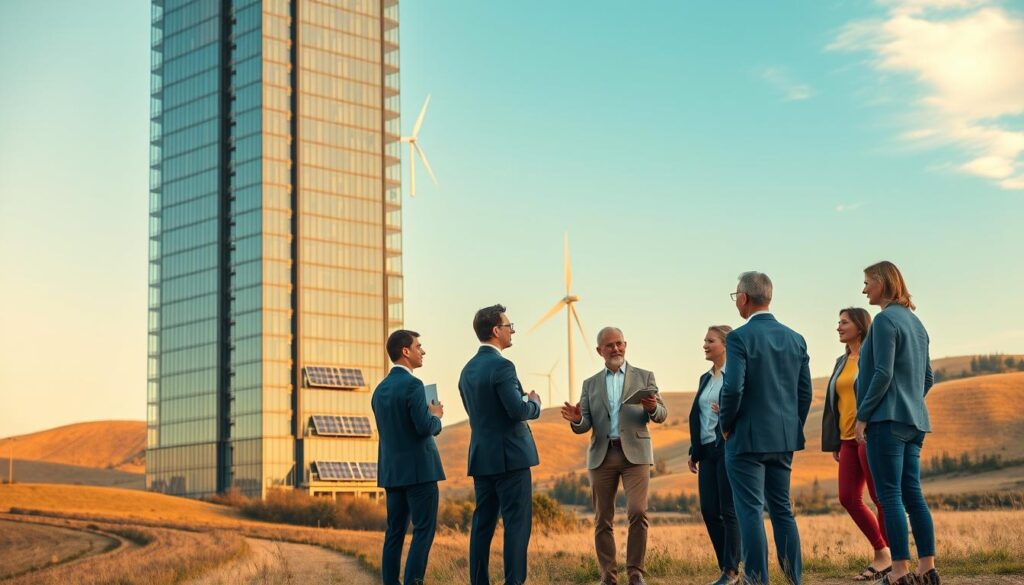
Green building initiatives face a multitude of challenges, from financial barriers to misconceptions about sustainability, that must be addressed for successful project implementation. Understanding these challenges is crucial for developers, architects, and policymakers to navigate the complexities of green building.
Common Barriers in Different Markets
The adoption of green building practices varies significantly across different markets due to various barriers. In some regions, the lack of awareness and understanding of sustainable practices hinders the adoption of green building. In other areas, regulatory frameworks and building codes may not support or incentivize green building sufficiently.
A closer look at these barriers reveals a complex interplay of factors. For instance, a study on international green building markets identified the following common barriers:
| Barrier | Description | Impact |
|---|---|---|
| Higher Upfront Costs | Increased initial investment for green technologies and materials. | Deters investment due to perceived high costs. |
| Lack of Awareness | Limited understanding of green building benefits among stakeholders. | Slows adoption due to skepticism. |
| Regulatory Hurdles | Insufficient or inconsistent regulations supporting green building. | Creates uncertainty and obstacles for green projects. |
Strategies to Overcome Financial Constraints
One of the significant challenges in implementing green building solutions is overcoming financial constraints. Strategies to address this include:
- Exploring Financing Options: Utilizing green bonds, grants, and other financial instruments designed to support sustainable projects.
- Energy Efficiency: Implementing energy-efficient technologies that reduce operational costs over time.
- Incentives and Tax Credits: Leveraging government incentives and tax credits available for green building projects.
Addressing Misconceptions in Sustainability
Misconceptions about sustainability can also hinder the progress of green building initiatives. Common misconceptions include the belief that green building is too expensive or that it compromises on quality and aesthetics. Addressing these misconceptions involves:
- Education and Awareness: Educating stakeholders about the long-term benefits and cost-effectiveness of green building.
- Showcasing Success Stories: Highlighting successful green building projects that demonstrate both sustainability and quality.
- Transparency: Being transparent about the materials, processes, and benefits of green building to build trust among stakeholders.
By understanding the challenges and implementing strategies to overcome them, the construction industry can move closer to achieving its sustainability goals.
Future Trends in Green Building Solutions
Emerging trends in green building are set to revolutionize the construction industry with eco-friendly solutions. As we look to the future, it’s clear that the sector will be shaped by a range of innovative technologies and sustainable practices.
Innovations on the Horizon
The future of green building is likely to be influenced by several key emerging technologies. Building-integrated photovoltaics (BIPV) are becoming increasingly popular, allowing buildings to generate their own energy while maintaining aesthetic appeal. Additionally, advancements in materials science are leading to the development of sustainable, durable materials that reduce environmental impact.
Another significant trend is the adoption of smart building technologies, which enhance energy efficiency and occupant comfort through advanced automation and monitoring systems. For more insights on current and future green building trends, visit Vitruvi Software’s blog on green building.
Predictions for Sustainable Construction
The construction industry is expected to shift towards more sustainable practices, driven by both regulatory requirements and consumer demand. Key predictions include:
- Increased use of recycled and recyclable materials
- Greater emphasis on energy-efficient design and operation
- Adoption of circular economy principles in construction projects
These trends are expected to not only reduce the environmental footprint of buildings but also improve their resilience and adaptability to future challenges.
The Role of Policy in Shaping the Future
Policy and regulation will play a crucial role in driving the adoption of green building practices. Governments around the world are implementing stricter building codes and offering incentives for sustainable construction. For instance, policies promoting the use of renewable energy and energy-efficient technologies are becoming more prevalent.
| Policy Area | Impact on Green Building | Examples |
|---|---|---|
| Building Codes | Stricter energy efficiency standards | LEED Certification, International Energy Conservation Code (IECC) |
| Incentives | Financial benefits for green building | Tax credits, grants for sustainable projects |
| Renewable Energy Mandates | Promotion of solar, wind energy | Renewable Portfolio Standards (RPS), solar panel installation incentives |
By understanding these trends and the factors driving them, stakeholders in the green building sector can better prepare for the future and contribute to a more sustainable built environment.
Resources for Further Learning
Continuing education is crucial for professionals in the green building sector. Access to the right resources can help builders and architects stay updated on the latest developments and best practices in sustainable construction.
Recommended Literature
Several publications offer insights into green building practices. These include books on sustainable design and energy-efficient construction methods, providing a foundation for understanding the principles of green building.
Online Education
Online courses and workshops are available for those looking to enhance their skills. These resources cover a range of topics, from energy-efficient systems to sustainable materials, supporting further learning and professional development.
Professional Networks
Joining professional organizations and networks can provide opportunities for collaboration and knowledge sharing. These groups often offer resources, including training programs and industry events, to support professionals in the green building sector.
